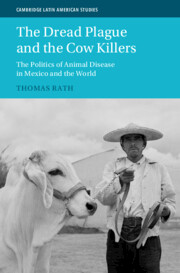‘Rath’s superb study is a model of intrepid historical investigation, explanatory clarity, analytical acuity, and narrative grace. The stories of faked pig deaths, cattle hidden in volcanic craters, strychnine-filled syringes strapped to the hoods of jeeps, armed livestock inspectors, and deadly assaults on veterinarians make for compelling reading. However, in Rath’s hands, they also constitute the all-too-human evidence of the bio-political stakes of managing animals and germs and the fraught development of Mexico’s post-revolutionary ‘livestock state’.’
Raymond Craib - Cornell University
‘Through a national and transnational narrative centered on humans, animals, germs, and their interactions, Rath shows there was nothing ‘natural’ about the disease and shows instead how capitalism, state-making, diplomacy, and scientific debate shaped the reception, diffusion, and eventual demise of this dreaded plague. A remarkable and vastly researched work that pushes against conventional narratives of domination, coercion, and resistance in Mexico and beyond.’
Gema Kloppe-Santamaría - author of In the Vortex of Violence: Lynching, Extralegal Justice and the State in Post-Revolutionary Mexico
‘This book is a must-read for anyone interested in postwar US-Mexico relations, social mechanisms of opposition, resistance and negotiation, modernization and development. Through extensive research, Rath with clarity analyzes the aftosa campaign and ties together its effect on state formation, international relations and the ecology of animal-human coexistence.’
Elisa Servín - Instituto Nacional de Antropología e Historia, Mexico
‘Rath’s story of cows and how to kill them is an extraordinary work. Told with verve, intelligence and a wry wit, it is an original meeting of political, environmental and new US imperial history. It also lays out - with clarity and style - the emergence of Mexico’s one-party state. One of the two or three most important books on mid-century Mexico.’
Benjamin T. Smith - author of The Dope: The Real History of the Mexican Drug Trade
‘… due to its merits and findings, the book will be of interest to scholars involved in the study of the agrarian, scientific, political, and environmental transformations of the Mexican countryside in the twentieth century.’
Netzahualco´yotl Luis Gutierrez
Source: Hispanic American Historical Review
‘Highly recommended.’
M. H. Albro
Source: Choice
‘… a must-read for anyone with an interest in twentieth-century history about Mexico, agriculture, US-Latin American politics, livestock, and the disease/pathogen movement. As broad as the movement seems, Rath’s astonishing book pulls off a wide-encompassing yet detailed work …’
Daniela Sclavo
Source: H-Environment
'‘[This book] weaves the history of animals, medicine, agriculture and foreign relations into a unique narrative that underscores how public health campaigns shape human and non-human interaction … Rath’s study fills a void in ecological, agricultural and animal histories … A skilled storyteller, Rath conveys distinct perspectives.’
Heather L McCrea
Source: Social History of Medicine
'A compelling, comprehensive, and well-researched story of the aftosa campaign and its place in the history of Mexico, animal disease campaigns, and international relations … the book makes important and valuable contributions to some big historical questions, and Rath tells an immensely interesting story about people and their animals.’
Source: European Journal for the History of Medicine and Health
‘Rath’s astonishing book pulls off a wide-encompassing yet detailed work. … his book provides a brilliant lens to engage with Mexico’s livestock history with a critical eye … By exploring the struggles between veterinarians and agricultural scientists to control animal husbandry, this book highlights the importance of animals, and not only crops, in imaginaries of development and progress.’
Source: H-Net Reviews
‘… in stressing the everyday resistance and mechanics as the campaign played out on the ground, Rath’s history makes for one of the most compelling and important accounts of a modern animal disease campaign. Historians of twentieth-century agriculture, animals, Mexico, and the United States will benefit immensely from grappling with how the midcentury dreams of scientific progress and modernization were ultimately dependent on the messiness at the heart of disease control campaigns like CMAEFA.’
Oliver Lazarus
Source: Agricultural History
‘Offers new insights into rural modernization, state formation, geopolitics, and the politics of science in Mexico and the Americas … it would also make for a terrific film.’
Source: Journal of Latin American Geography
‘Rath's project is original not only because of the way it intertwines different areas of study, but also because of the novelty of its sources, drawn from a wide variety of US, Mexican, and European archives … an important addition to the scholarship that is changing our understanding of mid-century Mexico.’
Adela Cedillo
Source: The Americas



